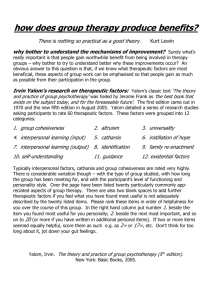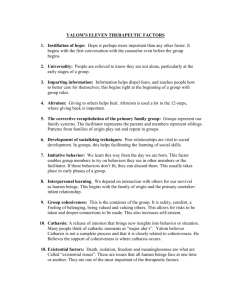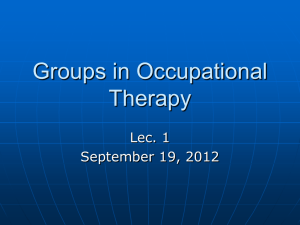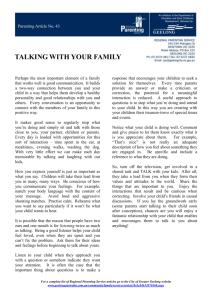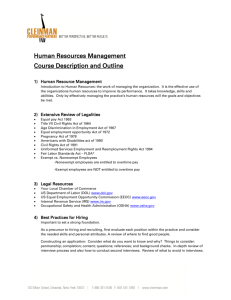1 L 1 Baptist Health School of Nursing NSG 3037: Psychiatric Mental
advertisement
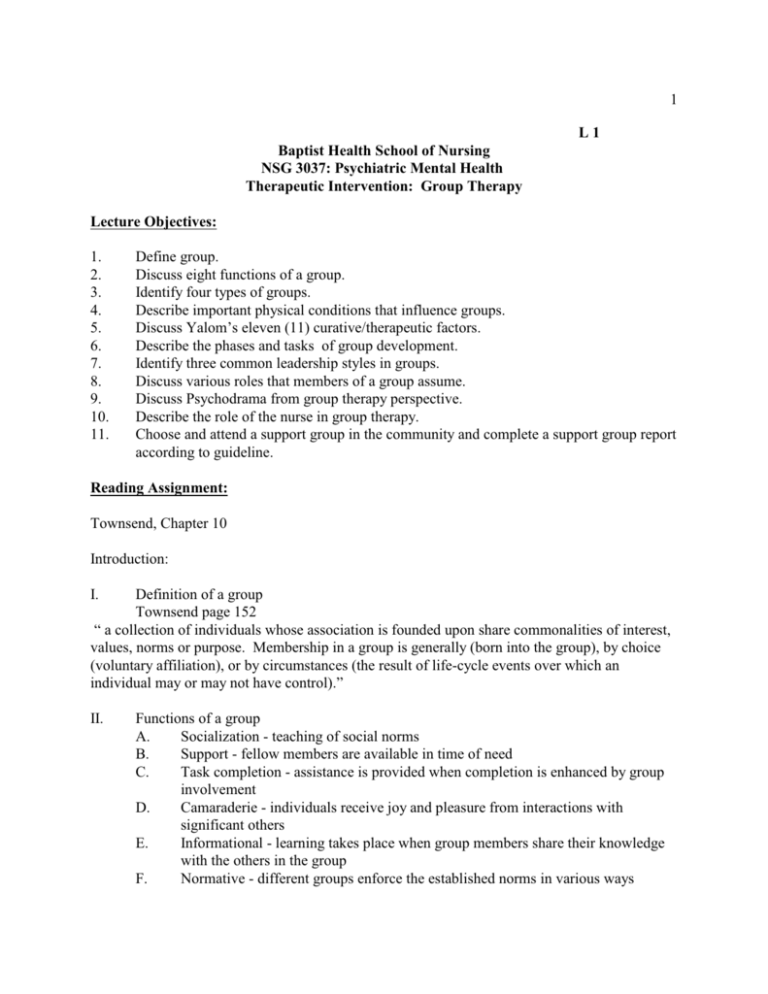
1 L1 Baptist Health School of Nursing NSG 3037: Psychiatric Mental Health Therapeutic Intervention: Group Therapy Lecture Objectives: 1. 2. 3. 4. 5. 6. 7. 8. 9. 10. 11. Define group. Discuss eight functions of a group. Identify four types of groups. Describe important physical conditions that influence groups. Discuss Yalom’s eleven (11) curative/therapeutic factors. Describe the phases and tasks of group development. Identify three common leadership styles in groups. Discuss various roles that members of a group assume. Discuss Psychodrama from group therapy perspective. Describe the role of the nurse in group therapy. Choose and attend a support group in the community and complete a support group report according to guideline. Reading Assignment: Townsend, Chapter 10 Introduction: I. Definition of a group Townsend page 152 “ a collection of individuals whose association is founded upon share commonalities of interest, values, norms or purpose. Membership in a group is generally (born into the group), by choice (voluntary affiliation), or by circumstances (the result of life-cycle events over which an individual may or may not have control).” II. Functions of a group A. Socialization - teaching of social norms B. Support - fellow members are available in time of need C. Task completion - assistance is provided when completion is enhanced by group involvement D. Camaraderie - individuals receive joy and pleasure from interactions with significant others E. Informational - learning takes place when group members share their knowledge with the others in the group F. Normative - different groups enforce the established norms in various ways 2 G. H. Empowerment - change can be effected by groups at times when individuals alone are ineffective Governance - large organizations often have leadership that is provided by groups rather than a single individual III. Types of group A. Task - a group formed to accomplish a specific outcome B. Teaching - focus is to convey knowledge and information to a number of individuals C. Supportive/therapeutic - the concern of these groups is to prevent possible future upsets by educating the participants in effective ways of dealing with emotional stress arising from situational or developmental crises 1. Therapeutic Groups versus Group Therapy a. Group therapy has a sound theoretical base and its leaders generally have advanced degrees. b. Therapeutic groups are based to a lesser degree in theory. Focus is on group relations, interactions between group members and the consideration of a selected issue c. Leaders of both types of groups must be knowledgeable about group process ( the way in which group members interact with each other), as well as group content (the topic or issue being discussed in the group). D. Self Help - composed of individuals with a similar problem. Serve to reduce the possibilities of further emotional distress leading to pathology and necessary treatment. May or may not have a professional leader. Run by members, and leadership often rotates from member to member IV. Physical Environment that influence group dynamics A. Seat - best when no barrier between members, for example, seating in a circle B. Size - size of group makes a difference in the interaction of members. 7 or 8 are favorable climate for optimal group interaction and relationship development C. Membership - two types of groups exist: 1. Open-ended groups - members leave and others join at any time 2. Closed - ended groups - all members join at the time the group is organized and terminate at the end of the designated length of time V. Yalom’s Curative/Therapeutic Factors (Townsend, page153-154) A. Instillation of Hope - gain hope by observing the progress of others in the group with similar problems and sees that his/her problems can also be resolved B. Universality - come to realize that they are not alone in the problems, thoughts, and feelings they are experiencing 3 C. D. E. F. G. H. I. J. K. VI. Imparting of Information - share knowledge. Leaders of teaching groups also provide information to group members Altruism - members provide assistance and support to each other, which heps to create a positive self-image, and promote self growth Corrective Recapitulation of the Primary Family Group - members are able to reexperience early family conflicts that remain unresolved Development of socializing Techniques - through interaction with and feedback from others within the group, individuals are able to correct maladaptive social behaviors and learn and develop new social skills Imitative Behavior - members who have mastered a particular psycho-social skill or developmental task serve as valuable role models for others Interpersonal Learning - the group offers many and varied opportunities for interacting with other people Group Cohesiveness - members develop a sense of belonging that separates the individual (“I am”) from the group (“We are”) Catharsis - encouraged to express both positive and negative feelings Existential Factors - the group is able to assist individual members to take direction of their own lives and to accept responsibility for the quality of their life Three Phases of Group Development- groups like individuals and families move through phases of development of infancy to maturity. A. Phase I - Initial/ Orientation (Beginning Phase) 1. Group activities d. Establish rules that will govern group (when and where meetings will occur, importance of confidentiality, how meetings will be structured. Goals of the group are established. Members introduced to each other 2. Leader expectations a. Orient members to specific group processes, encourage members to participate, promote environment of TRUST, and ensure that rules established do not interfere with meeting goals b. Begin to focus on Here and Now 3. Member behaviors a. Have not yet established TRUST. Fear of not being accepted. May try to “get on good side” with complements and conforming, Power struggle may ensue as members complete for their position in the “pecking” order of the group B. Phase II - Middle or Working Phase 1. Group activities a. Establish cohesiveness b. Productive work is accomplished toward goal c. Problem solving and decision making occurs 4 d. 2. In a MATURE group cooperation prevails, and differences and disagreements are confronted and resolved Leader expectations a. Role of leader diminishes. Becomes more of facilitator b. Leadership is shared by members of group c. Helps resolves conflict and continues to foster cohesiveness d. Helps members stay focused on Here and Now and goal 3. Member behaviors a. Trust has been established b. Turn more often to each other instead of leader c. Accept criticism, using it in a constructive way to create change d. Subgroups may form where two or more members conspire, excluding the entire group. To maintain cohesion, sub-groups must be confronted and discussed by entire membership e. Conflict is managed by group with minimal assistance from leader C. Phase III - Final or Termination Phase 1. Group activities a. Termination must be discussed at the onset of group formation. The longer a group has been in existence, the more difficult to terminate b. Should be discussed in depth several meeting prior to termination c. Expect to grieve loss related to termination phase of group 2. Leader expectations a. Encourages members to reminisce about what has occurred within group, to review goals and discuss actual outcomes and to encourage members to provide feedback to each other about individual progress within the group. b. Encourages members to discuss feelings of loss associated with termination of group 3. Member behaviors a. May express surprise over actual materialization of the end. This represents the grief response of denial, an may progress to anger. b. Anger toward other group members or leader may reflect feelings of abandonment. c. Expressing these feelings may lead to individual members’ discussing previous losses where similar emotions were experienced. d. Successful termination of group may help members develop skills needed when losses occur on other parts of their lives Removing(withdrawing or throwing out) a member from group!!!! 5 VII. Basic styles of group leadership Leadership style is determined by the demands of the therapeutic situation. An effective leader ensures the structuring process for the group, clarifies expectations, and maintains cohesiveness as new members are introduced into the group. Generally, a leader structures group by determining group size and homogeneity of members. A. Autocratic - focus is on the leader, on whom the members are dependent for problem solving, decision making, and permission to perform. Production is high, but morale is low 1. Significant leader authority and control 2. Rarely seeks/uses group member input 3. Doesn’t encourage participation/interaction of the group 4. Effective during emergencies 5. Benefits -conserves time/energy. Roles/responsibilities dictated to group members 6. Disadvantages - hostility, scape-goating may occur, dependence on leader, limited group growth B. Democratic - the focus is on the members who are encouraged to participate fully in problem solving of issues that relate to the group, including taking action to effect change. Production is somewhat lower than it is with autocratic leadership but moral is much higher. 1. Encourages group participation 2. Decision-making and problem solving are group directed 3. Seeks/values member input/feedback 4. Encourages open communication 5. Members rewarded for their contributions 6. Group work tailored to common goals 7. Benefits - more productive, cohesive 8. Disadvantages - more time/effort needed to accomplish goals C. Laissez-Faire - there is no focus in this type of leadership. Goals are undefined, and members do as they please. Productivity and morale is low. 1. Wide open - free to operate at will 2. Most effective with highly motivated, very knowledgeable, task oriented members 3. Benefits - fosters creativity 4. Disadvantages- time-consuming and may be inefficient VIII. Member Roles - members play one of 3 types of roles within the group A. Complete task of the group B. Maintain or enhance group processes C. Fulfill personal or individual needs D. Task Roles, Maintenance Roles, and Personal Roles (see table 10-2 page 157, Townsend) 6 1. 2. 3. IX. Task roles - roles that serve to complete the task of the group a. Coordinator b. Evaluator c. Elaborator d. Energizer e. Initiator f. Orienter Maintenance roles - roles that serve to maintain or enhance group processes a. Compromiser b. Encourager c. Follower d. Gatekeeper e. Harmonizer Personal (individual) roles - roles that serve to fullfill personal or indvidual roles a. Aggressor b. Blocker c. Dominator d. Help-seeker e. Monopolizer f. Mute or silent member g. Recognition seeker h. Seducer Psychodrama A. Definition - a special type of group therapy that employs a dramatic approach in which patients act out life situation scenarios. B. Roles 1. Director - group leader 2. Audience - group members play the roles of people with whom the protagonist has unresolved issues. Group members who do not participate in the drama act as the audience 3. Set/stage 4. Protagonist - identified patient selects a life situation to portray C. The purpose is to provide the patient with a safe place in which to confront unresolved conflicts and hopefully progress toward resolution 7 X. Role of the nurse in group therapy A. Leader/facilitator 1. Psychoeducation group 2. Self esteem group 3. Assertiveness training 4. Relaxation group 5. Parent group 6. Others B. Understand group process XI. How to go about choosing a community support group to attend and complete written report. In the daily newspaper there is a listing of meetings - AA, Al Anon, NA, CA, Parents without partners, Divorce group, Overeaters and Gamblers A, SHARE. Etc grouptherapy/06
